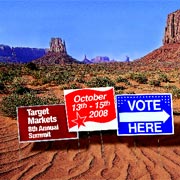Special Section sponsored by TMPAA |
||||||||||||||
Identifying Potential Program Markets MarketStance focuses on four key factors The program insurance market has been growing consistently in the last few years and all signs point to a continuation of that growth. Especially in a soft market, agents who are watching their commission revenues dwindle sometimes seek expansion to replace lost commission dollars. One way to do that is to develop new programs that might be of interest to their carriers. Then, too, on the heels of two very profitable years for the insurance industry, new capital is coming into the marketplace, anxious to start up programs of their own. And carriers have found programs particularly worthwhile in light of the increased competition they are facing in the marketplace. But how do you determine what programs will be successful and which will not? Rough Notes recently discussed that very subject with Fritz Yohn, CEO of MarketStance, a Middletown, Connecticut-based research and data gathering firm that specializes in the insurance industry. “We asked ourselves if it is possible to find some characteristics that will point to successful programs,” says Yohn. “We wanted to be able to provide a game plan for agents and carriers when considering a particular program. We found four different key factors to creating a viable insurance program,” he says. The four key factors, according to Yohn, are: • Is there enough premium potential? Says Yohn: “The first question is a pretty obvious one. If there isn’t enough premium potential, then there’s no need to go any further. As for homogeneity, if all members of the group operate the same business, that’s fine. But if there are members who also operate ancillary businesses, those members could potentially present a higher risk. “The same holds true for the size of members,” he continues. “If all members are small commercial accounts, that’s a good sign, but if a closer look indicates that there are some middle market exposures in the group, that could mean trouble down the line. “As for geographic consistency, if members of the group are spread all over the country, you’re going to need a great many agents to market and service the accounts, whereas if the group members are located in the same area of the country, the program can be operated with greater efficiency.” Yohn says that his people decided to take a look at gas stations to see how they stack up to these characteristics. “Nationally, there are about 125,000 gas stations out there,” he says. “The industry represents roughly $2 billion in premiums, so that satisfies characteristic number one. But then come the caveats. There are small gas stations in the marketplace, and there are large ones. Either group might represent a viable program, but to try to include them all would be a mistake. “Geographically, the gas stations are concentrated on the East Coast, the Midwest and the West Coast. Here the decision is which of those markets can be more easily penetrated and which can provide the most premium dollars,” he says. “But there’s more,” continues Yohn. “When you look at gas stations, you must determine how much of their receipts comes from selling fuel. We found that, nationally, 70% of gas stations fall into the category of only selling fuel. That means that 30% of gas stations have receipts from selling some product or service other than fuel. “We used government data to find out what’s in that 30% and discovered that a surprising number of gas stations sell beer, wine and other alcoholic products,” he explains. “That opens up the area of liquor liability. Some perform repair work, which would require separate coverage.” If all that isn’t enough, Yohn says that 68% of gas stations also have convenience stores. Roughly 28,000 don’t have convenience stores, while about 90,000 gas stations do. “You can go either way to set up a program, but don’t mix the two,” he says. “Another way to separate gas stations,” says Yohn, “is by determining which gas stations do repair work and have convenience stores. Then you should separate the single gas stations from the multiple gas stations. We found that 70% of single stations have convenience stores as well. They are concentrated primarily in the East Coast and California, but not in the Midwest and Mountain States.” Yohn says that the whole purpose of what MarketStance has done here is to bring home the point that starting up a program requires a good deal of thinking and analyzing. “You take a potential market and break it down, then break it down some more. We think our four key characteristics will be helpful to those just starting in the program insurance business as well as those who are looking to add new programs to their portfolios.” *
|
|
|||||||||||||
